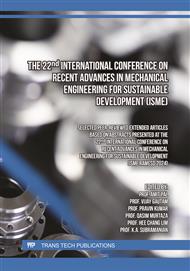[1]
Wang, P., Zou, B., Xiao, H., Ding, S., & Huang, C. (2019). Effects of printing parameters of fused deposition modeling on mechanical properties, surface quality, and microstructure of PEEK. Journal of Materials Processing Technology, 271, 62-74.
DOI: 10.1016/j.jmatprotec.2019.03.016
Google Scholar
[2]
Macdonald, E., Salas, R., Espalin, D., Perez, M., Aguilera, E., Muse, D., & Wicker, R. B. (2014). 3D printing for the rapid prototyping of structural electronics. IEEE access, 2, 234-242.
DOI: 10.1109/access.2014.2311810
Google Scholar
[3]
Lazarus, N., & Tsang, H. H. (2020). 3-D printing structural electronics with conductive filaments. IEEE Transactions on Components, Packaging and Manufacturing Technology, 10(12), 1965-1972.
DOI: 10.1109/tcpmt.2020.3038563
Google Scholar
[4]
Penumakala, P. K., Santo, J., & Thomas, A. (2020). A critical review on the fused deposition modeling of thermoplastic polymer composites. Composites Part B: Engineering, 201, 108336.
DOI: 10.1016/j.compositesb.2020.108336
Google Scholar
[5]
Zhang, G., Lan, H., Qian, L., Zhao, J., & Wang, F. (2020). A microscale 3D printing based on the electric-field-driven jet. 3D Printing and Additive Manufacturing, 7(1), 37-44.
DOI: 10.1089/3dp.2018.0154
Google Scholar
[6]
Church, K. H., Tsang, H., Rodriguez, R., Defembaugh, P., & Rumpf, R. (2013, July). Printed circuit structures, the evolution of printed circuit boards. In IPC APEX EXPO Conference Proceedings.
Google Scholar
[7]
Bekas, D. G., Hou, Y., Liu, Y., & Panesar, A. (2019). 3D printing to enable multifunctionality in polymer-based composites: A review. Composites Part B: Engineering, 179, 107540.
DOI: 10.1016/j.compositesb.2019.107540
Google Scholar
[8]
Aguilera, E., Ramos, J., Espalin, D., Cedillos, F., Muse, D., Wicker, R., & MacDonald, E. (2013). 3D printing of electro mechanical systems. In 2013 International Solid Freeform Fabrication Symposium. University of Texas at Austin.
DOI: 10.1109/icsens.2013.6688247
Google Scholar
[9]
Abeykoon, C., Sri-Amphorn, P., & Fernando, A. (2020). Optimization of fused deposition modeling parameters for improved PLA and ABS 3D printed structures. International Journal of Lightweight Materials and Manufacture, 3(3), 284-297.
DOI: 10.1016/j.ijlmm.2020.03.003
Google Scholar
[10]
Xu, Y., & Deng, C. (2017, April). An investigation on 3D printing technology for power electronic converters. In 2017 IEEE 8th International Symposium on Power Electronics for Distributed Generation Systems (PEDG) (pp.1-6). IEEE.
DOI: 10.1109/pedg.2017.7972486
Google Scholar
[11]
Barile, G., Esposito, P., Possemato, A., Stornelli, V., & Ferri, G. (2023, September). Design and Manufacture of 3D-Printed Circuit Boards. In Annual Meeting of the Italian Electronics Society (pp.402-413). Cham: Springer Nature Switzerland.
DOI: 10.1007/978-3-031-48711-8_49
Google Scholar
[12]
Al-Araji, Z. H., Swaikat, N. A., Muratov, A., & Turetsky, A. V. (2019, April). Modeling and experimental research of vibration n properties of a multi-layer printed circuit board. In 2019 4th Scientific International Conference Najaf (SICN) (pp.43-47). IEEE.
DOI: 10.1109/sicn47020.2019.9019364
Google Scholar



